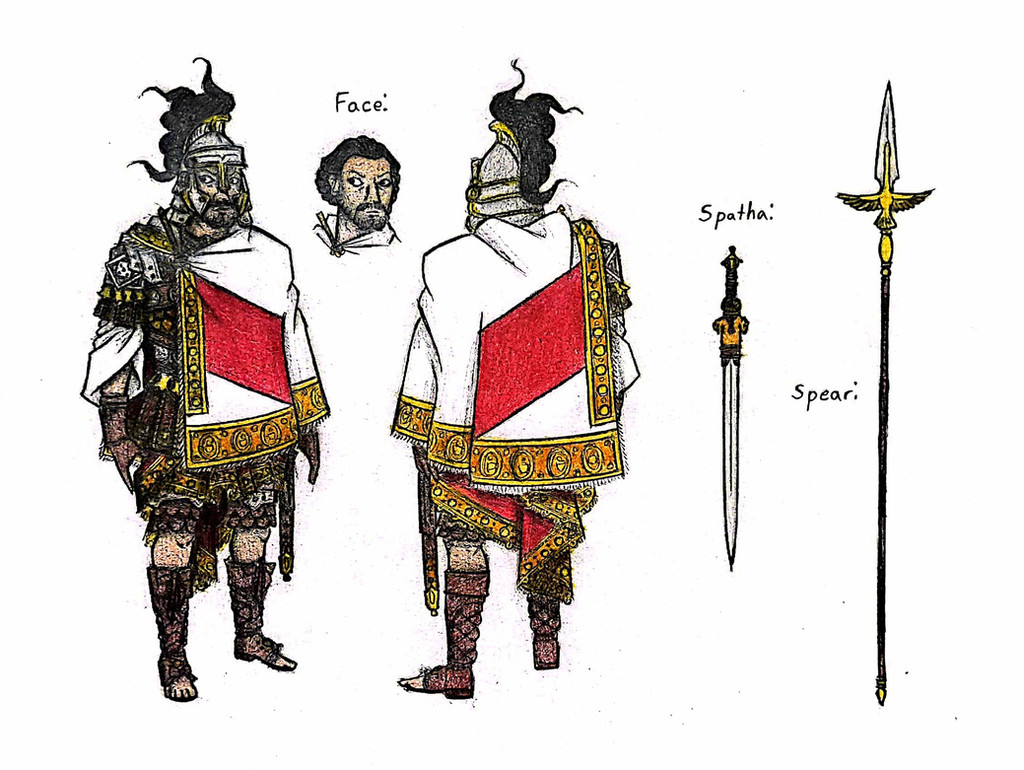HOME | DD
 Avapithecus — Belisarius
Avapithecus — Belisarius

#belisarius #byzantine #character #design #general #history #military #referencesheet #roman #rome #soldier
Published: 2023-07-23 16:05:05 +0000 UTC; Views: 7016; Favourites: 88; Downloads: 0
Redirect to original
Description
Flavius Belisarius is one of the most badass motherfuckers the Roman Empire has ever pumped out. He did not win the most battles nor slay the most foes, but he was renowned in his time as a noble warrior with a level-head and respect for both his men and his enemy. Born around 505 CE in the province of Illyria, Belisarius first won his fame during his service fighting in the Iberian War in 530. Initially, their Iranian foes ran circles around the Romans, and Belisarius found himself held up in the fortress of Dara with only half the men the Sassanids had. A Sassanid messenger even sent word to Belisarius from the enemy commander requesting that Belisarius "draw me a bath, for tomorrow I will bath in your city". Belisarius, always using his head to get out of a situation, orchestrated a trap to keep the Sassanid infantry pinned behind a trench while the Romans' Hunnic allies destroyed their cavalry. The victory was brilliant and spectacular, and in fact we know the details quite clearly. Court historian Procopius, our primary source on this period, was sent to tail Belisarius on the first 15 years of his adventures, making him an invaluable eye-witness to the most important military events of the time. It's a historian's wet dream, just like most of Justinian's reign to be honest. I just love these characters so much.Belisarius's victory at the Battle of Dara was the first domino which led to the treaty of the so called "Eternal Peace" with the Iranians in 532. For his brilliance, Belisarius was rewarded handsomely, and became a close personal friend with Emperor Justinian himself. It's a good thing, too, because that meant Belisarius was in Constantinople when the Nika Riots broke out soon after. Initially, this was a terrifying union of rival sports mobs calling for the lives of two hanged men from both teams. Men with more brain cells than your average chariot hooligan were pulling the strings, however, men who wanted to usurp Justinian's court and replace him with Hypatius, nephew of Emperor Anastasius. Hypatius, however, did not want to be emperor. Dude had a good thing going under Justinian and being emperor is just too much pressure man! When Belisarius found him, he was being held against his will by an angry mob demanding he take a crown he kept insisting he didn't want like it's Life of Brian. Belisarius wanted to get in, arrest Hypatius, and get out, but the way was blocked, and so he was left with no choice. Together with fellow commander Mundus, he led a strike team into the stadium and cut his way through the rioters until they dispersed. 30,000 men lay dead that day, and Justinian's reign was never challenged again. I never said Belisarius was perfect, but he always tried to take the path of minimal bloodshed before anything else.
It is this level-headedness that led Justinian to select Belisarius to lead the charge on his ultimate dream: the reconquest of the Western Roman Empire from the Germanic Kingdoms. In 530, Hilderic, king of the Vandals, was deposed by his cousin Gelimer and a faction of anti-Roman noblemen. Justinian jumped at the opportunity to declare war, and sent Belisarius marching into North Africa in 533. Belisarius had a much weaker force than previous Roman attempts to retake the region, but again, he had his wits. He orchestrated revolts in the Mediterranean to distract the Vandals, while simultaneously winning the support of the people by preventing his men from looting the countryside like some petty barbarians. These were civilians whose grandparents still remember being under the Roman eagle, afterall. They were Roman citizens, and Belisarius would have them treated as nothing less. By 534, Carthage was in Roman hands, and Gelimer was captured. For his valiance, Justinian awarded Belisarius the highest honor: a Triumph, the last any Roman general would ever receive. With the Vandals out of the way, the path was now open to sail up to the boot of Italy and march north for the grand prize: the Eternal City, Rome.
In 535, the Queen of the Ostrogoths who held Rome, Amalasuintha, was assassinated by conspirators who knew they would be Justinian's next target if her pro-Roman council was allowed to continue. Unfortunately for them, this was the exact excuse Justinian needed to invade Italy and "secure" the provinces. Belisarius took Sicily first, then made his way up the boot. The war was agonizingly slow, as Belisarius had few men at his disposal since he had to maintain a force in North Africa to secure the borders. For the most part though, things went smoothly. There was a bit of a hiccup at Neapolis, though luck would have it he was able to sneak his army in via the old city aqueduct. Seeing just how awesome Belisarius was, the Ostrogoths decided it was time to usurp the usurper to replace him with a stronger leader. They selected as their new king the half-elf Vitiges, who cut his losses and withdrew from Rome so that he could gather an elite strike force in Ravenna. In 536, Belisarius was able to walk right into the Eternal City. Rome was, for the first time in 60 years, controlled by Romans, and the story really should've just ended there.
Unfortunately, keeping Rome was an incredibly daunting task. Belisarius might have been a military genius, but there's only so much even he can do with just a few thousand men in a city which was already falling into ruin by this point in history. The Ostrogoths besieged Rome from 537 through to 538. Though Belisarius managed to outlast the invaders, the most fragile cracks are always the ones from within. His subordinates, Narses and John, were overly proud and reckless men who bickered with Belisarius and made fortress hopping way more difficult than it needed to be. They didn't reach Ravenna until 540, which was extremely bad timing, because that was just enough time for the elven king to beg the Sassanids to break the "Eternal Peace". War erupted in Lazica, and Justinian had no choice but to recall Belisarius and secure the Eastern border. Belisarius, quite literally sitting right outside the final Ostrogothic stronghold, was absolutely piiiiiiissed. This was like your console coming unplugged right in the middle of the final boss you've grinded so hard to beat. Immediately, he started looking for a way to either stall his departure or get inside Ravenna now. As it happened, Vitiges had a backup scheme he was initiating. He struck a deal with Belisarius that he would let him in if Belisarius agreed to usurp the throne as Western Roman Emperor. Belisarius took the deal, walked inside, booted Vitiges out, and then declared he would never betray his friend Justinian like that. It was a trick, and though it won them the day, it rubbed everyone the wrong way.
The Ostrogoths of course were pissed off that this most noble of Romans signed a treaty and then completely dicked them over on it. Justinian, meanwhile, felt the specter of betrayal. Yes, Belisarius refused the title of Emperor, but he also disobeyed an imperial order, and signed a real treaty accepting that imperium to do it. Belisarius sacrificed everyone's trust in him for Ravenna, and that specter only got darker when the great Plague of 542 struck. Belisarius had sworn that he'd never accept a crown so long as Justinian lived, but now… Justinian laid in bed, unconscious, his skin rotting as black bubonic boils blistered his flesh. Rumors spread, but to his credit, Belisarius continued to dissuade these rumors. He would not betray his friend like that, not in such a dark a time as this. Still, let's not forget how insistent mob rule can be with a man who blatantly doesn't want to be emperor. Theodora, Justinian's beloved wife, certainly didn't. She was friends with Belisarius's wife, and had no real beef with him personally, but she was an Empress first and foremost. The risk simply could not be tolerated in these desperate times, and so she had Belisarius removed from his post. Justinian, miraculously, survived the Plague, though, and by 544, Theodora had used her friendship with Belisarius's wife to reinstate his privileges. He was posted back in Italy, but by then the damage was already done.
His squabbling, undisciplined subordinates had lost their conquests to the Ostrogoths who were now united under King Totila, including Rome herself in 546. Claiming the Italian Peninsula became one seriously unfunny game of Pong between the Goths and the Byzantines. In 548, Belisarius was at last recalled to Constantinople, where he retired with full honors, but at the cost of losing his dream and the trust of his best friend. He was briefly dragged out of retirement in 559 to defend the border from a band of marauding Huns, but this was a short glory. In 562, he was accused of participating in a conspiracy against Justinian, but thankfully his old friend found it in his heart to waive the charges and let him live out the rest of his retirement in peace. Popular legend has it very differently, claiming that Justinian had Belisarius's eyes poked out and cast him into the streets as a lowly beggar. Most modern historians consider this a fantasy made up by later medieval authors, as there's no contemporary evidence, even from Justinian's critics, of this happening. The earliest source of this myth that I've been able to dig up is from the works of the 12th century monk John Tzetzes, who was clearly trying to criticize the important political figures of his own day without… you know… getting his eyes gouged out and thrown onto the streets as a lowly beggar.
Design notes, Belisarius is depicted in the mosaics of the Basilica of San Vitale alongside Justinian, though in civilian clothes. I took the headshot from the mosaic, and turned to modern sources to deck him out a little more. Unfortunately, most modern works of art like to focus on the myth of him being blinded, which is really such a shame for a guy who was as badass as Belisarius. I wanted to depict the man who took back Rome by tooth and nail, so to compose his armor, I took inspiration from a 17th century piece by Salvator Rosa, as well as a couple of illustrations apparently from the 19th century. I say apparently because the stock image sites which host these images don't bother to give any further citations as to where they come from, and yet they seem to be the only places on the internet they exist on. Grrrrr. Ah well. The end result is a little messy, but I'm pleased with it. To me, this is exactly the sort of dashing, commanding presence I would expect to be worthy of a man parading through a Roman Triumph.
Related content
Comments: 8

👍: 1 ⏩: 1

👍: 0 ⏩: 0

👍: 2 ⏩: 1

👍: 2 ⏩: 0

👍: 3 ⏩: 1

👍: 1 ⏩: 1

👍: 0 ⏩: 1

👍: 1 ⏩: 0
























